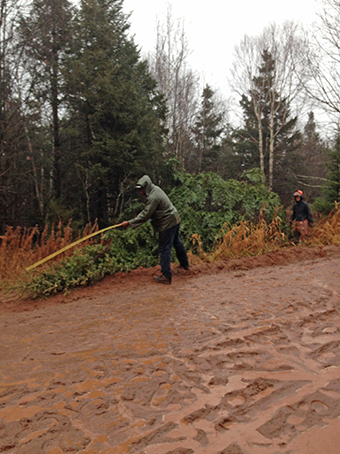Yes, in answer to that age-old question, when a tree falls in the forest, it makes a sound.
Department of Natural Resources (DNR) forestry staff know that better than most people, especially those on the crew to deliver a 30-foot tree to the Minnesota Governor’s Mansion for the Christmas season.
Jean Mouelle, born in what was then French Congo and educated in forest preservation, made the final selection of the state tree from General C.C. Andrews State Forest in Pine County. The balsam fir was delivered to the St. Paul address on December 3.
Mouelle, 61, whose title is regional silviculturist and road specialist, is known nationally and internationally for forestry and logging protection, conservation and harvest. A pretty good problem solver, he’s found solutions in use today that early on, seemed outlandish.
Consider these.
He figured out a better way to harvest mahogany trees in east central Africa.
He figured out a better way to harvest trees in Idaho that gave family-owned logging operations a fighting chance against the big logging industries.
He figured out a way to cut a big tree in a way that guarantees where it will fall without smashing branches once it lands. For that skill, Mouelle did research, practiced with a chainsaw, and today oversees the cutting and removal of the 500 to 900-pound pine from a Minnesota forest and delivering it to St. Paul.
A 21-year DNR employee, Mouelle’s career and life have been rich and eventful, pocked with a few tragedies and challenges.
In conversation with him, however, difficulties receive slight mention. He’s a natural, optimistic storyteller with a life story that reaches from a remote African village where he spent a few years as a child, to his earning a Ph.D. in Idaho, followed by a move to Minnesota.
The early years demonstrate the greatest contrast between then and now. He was born in a city and for a few years as a boy, lived in a remote African village that lacked electricity and running water. Children played soccer with a ball handmade from leaves. Everyone shared what little they had.
“It was there that I fell in love with nature and where I developed an interest in forestry,” he said. Mouelle learned the benefits of cooperation and sharing, traits that benefit the whole group. That early lesson becomes evident today through a simple question. Jean Mouelle, what tree should we plant in our yards? “Fruit trees,” he said immediately. “They’re not too tall, they give shade, and they give fruit in the fall.” Extra bounty can be shared with friends or a food shelf, he said. In addition, he encourages home gardening in the ground or through containers. He located land and helped fellow church members plant small plots.
Mouelle has planted and protected trees for a long time. As a young man, he attended the Rural Development Institute in Congo for engineering, rural development and forest management, and figured out way to harvest valuable mahogany trees that used the whole tree. He also espoused replanting trees. Not everyone embraced the new methods, especially large corporations.
“When you stand in the way of a corporation, it’s a no-no.” he said. Fortunately at that time he received a scholarship to study agri-forestry at the University of Idaho in Moscow, Idaho.
Mouelle said that his exposure to tropical and U.S. forestry and the differing methods of tree harvest gave him a broad understanding of the world and the management of natural resources. In Idaho he received a M.A. in agri-forestry and range resources and a PhD. in forest management.
That education and background give Mouelle a keen eye in the search for an ideal Christmas pine for the Governor’s Mansion. Brian Strock, a 19-year veteran technician with the DNR, keeps an eye out year-round for well-shaped evergreen with short needles, like balsam fir or white spruce.
The tree must be near a road so it can be transported, and ample space is needed for the fall. Each November, Strock finds three to five trees for Mouelle to choose from.
“Jean has the last say,” Strock said. “He’s the chief picker.” A chainsaw fells the tree so it moves downward slowly in a predetermined direction. Witnesses hear a pop and squeak as the tree falls to a tarp. The tree is placed on a trailer and delivered to St. Paul the next day where staff from the Governor’s Mansion wait with a crane.
DNR interns often help with the Christmas tree harvest, and provide youthful enthusiasm when the tree falls, Mouelle said. “You hear them scream and that makes me happy,” he said.
On balance, the tree removal requires a small fraction of Mouelle’s education and experience. Yet he is happy to act as crew coach because traditions are important to maintain, he said. After Christmas, the big tree is transported to a St. Paul yard and chipped for mulch, where it enters another phase of its life: to keep still-growing trees moist.
“Those chips will nourish another tree,” he said. “They’ll close the cycle of life.”
























